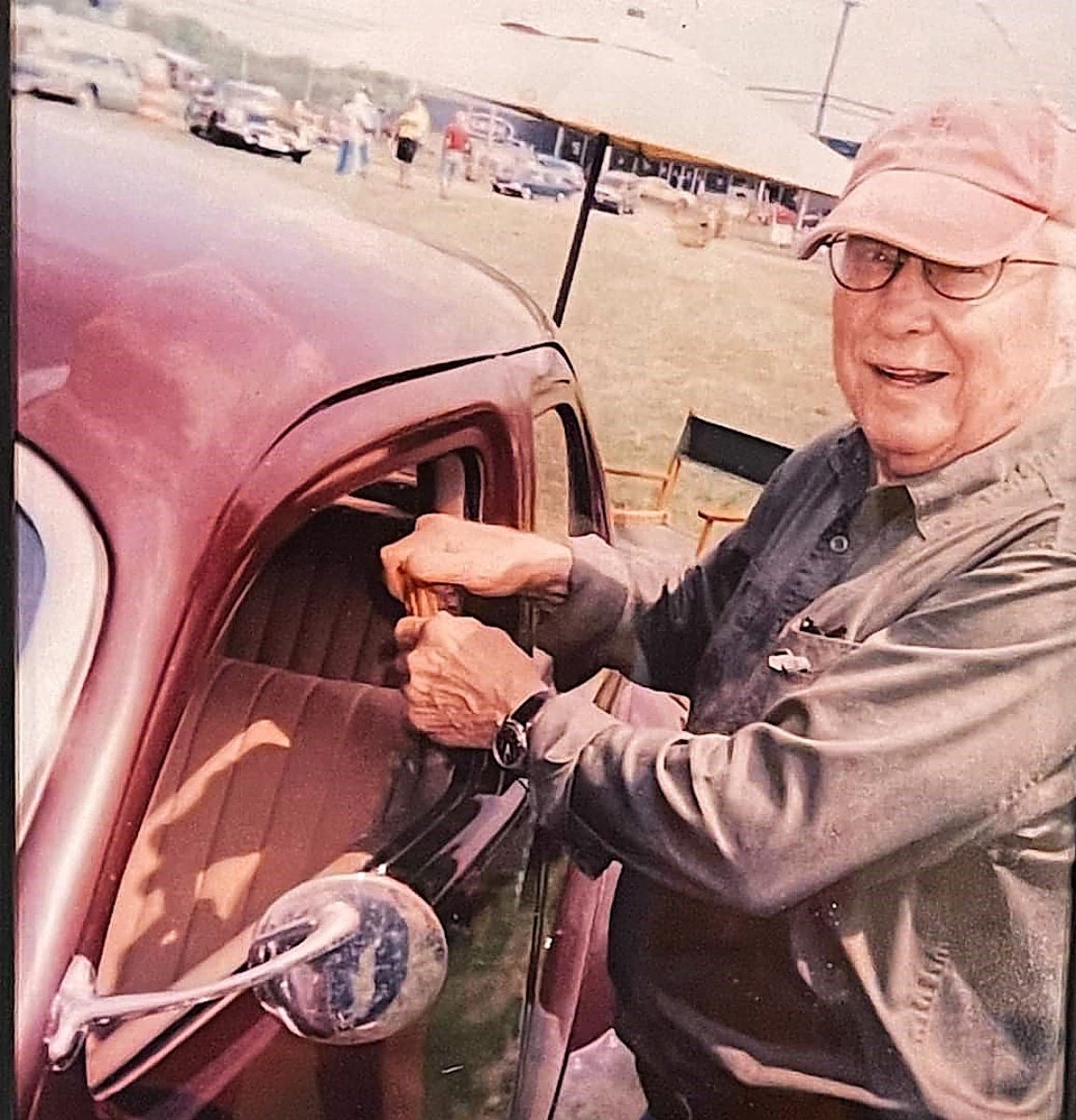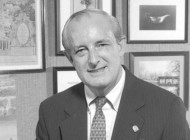
Keno standing with cat “Blackie” in front of the doorway of the Nineteenth Century stone “Smoke house” which still stands today on the Keno property.
Submitted by the family
MOHAWK, N.Y. – Ronald “Ron” A. Keno passed away peacefully after a brief battle with cancer on Monday, June 21, at the age of 90. He was born on August 17, 1930, the son of Leslie and Anna Keno and was a lifelong resident of Mohawk. Keno’s great grandparents, Francois Cuenot and wife, Marie, were born in France and emigrated to America, arriving in New York in 1874. His ancestors have a long history in New York State beginning in the mid-Seventeenth Century, particularly in the Upper Hudson River Valley, including Albany, Schenectady, Saratoga and Montgomery counties. Keno’s maternal grandmother, Delphine Devenpeck was a direct descendant of Cornelius Van Horne, who fought in the third regiment of the Tryon Militia in the Battle of Oriskany, considered to be one of the turning points in the Revolutionary War.
Keno’s eighth great-grandfather was General Philip J. Schuyler (1733-1804), who married Catherine Van Rensselaer, in 1755. Catherine’s mother was Angelica Livingston, (b Fort Orange, Albany, July 17, 1698). As a member of the Continental Congress for several terms, a United States Senator for New York in 1755, and an experienced officer, Schuyler was given the rank of Major General on June 19, 1775, making him third in command of the Revolutionary Army under George Washington. His primary home was the Schuyler Mansion in Albany. Philip Schuyler’s country estate, farm, various mills and multiple businesses and stores were the genesis of the village of Old Saratoga, now called Schuylerville.
Keno attended Mohawk High School and was educated at Syracuse University, graduating with a BA in art. In 1952, he married the former Norma Sweet of Herkimer, with whom he had a devoted, loving union of 49 years until her passing in February, 2001. He was a much beloved high school art teacher in Herkimer for more than 25 years.

Keno is seen here in an undated photo at Brimfield Flea Market with an early boldly painted pine dome-top trunk.
The Kenos were passionate about antiques and soon opened their first antiques shop in the front center room of the house, and then later relocated to a small barn on the property. It wasn’t very long before Keno and his family began exhibiting at antiques shows across the Eastern Seaboard. The Kenos began to expand what started as a hobby into a business, embarking on a lifelong adventure searching for treasures.
Shortly after his graduation from college, Keno began his career as an art teacher at Herkimer High School; he spent approximately eight years during the summer as an ironworker. He once said that beginning at a young age, he always had a fascination for bridges. His three sons – oldest son Mitchell and twin sons, Leigh and Leslie – have vivid memories of being in awe while watching their father casually walking across thin steel beams hundreds of feet in the air without safety ropes or scaling the interior walls of the large red barn to repair the roof. They maintain that their father’s courage together with his strong desire to help other people, and animals, in need was the reason they never followed comic book or cinema superheroes. In their words, “Dad was our own ‘superhero’ and the best role model a son could ever ask for.” Throughout their lives, Keno’s sons met countless people who were in their father’s art class, they would almost always make mention of the positive effects he had on their lives or careers. While growing up, the twins had some good friends of theirs from Herkimer who had Keno as their teacher who told them that he was “more of a father to them than their own father.”
The late 1960s and 1970s brought on a massive increase in the number of new antique shows, antique shops and outdoor shows. The Brimfield Flea Market was one of the Kenos’ favorite flea markets and the family exhibited there three times a year. When the gates opened early in the morning, the long caravan of vans and trucks would flow onto the field. Keno packed the barbecue and Norma would always serve home-cooked meals for their ever-growing group of friends. The Kenos eventually met the now legendary Russell Carrell and exhibited for many years at flea markets that Russell organized throughout New England and New York State; he was one of the first, if not the very first show managers in America, to invite dealers who shared his personal passion for decorative arts and furniture from the Seventeenth through early Nineteenth Century. Several of the Kenos’ favorite shows were the Salisbury show, The Golden Ball Tavern Show and The Shaker Museum in Chatham, N.Y.
Once Keno put his mind to something, there was not a lot that could stand in his way. He was especially supportive of his three boys. One particularly memorable example was in approximately 1971, when the twins opened their mail one afternoon, only to have photos spill-out of a marked large 6-gallon stoneware crock decorated with a cobalt blue elephant wearing boots. The asking price was $600! Leslie and Leigh made a quick phone call to the folk art dealers who owned it and within an hour, Ron was behind the wheel en route to their shop driving the entire night to a small town north of Detroit, Mich. The crock became one of the most important pieces in his sons’ growing stoneware collection.
The Kenos found tremendous joy through having meals or just coffee with the countless visitors who visited their home. Discovery stories were shared by all. In the wintertime, the Nineteenth Century stove was always ablaze, and an endless stream of visitors was almost always guaranteed. They went out of their way to welcome others into their home. Keno always tried his utmost to help others in need as did Norma. A good friend of our parents was heavy to the degree that a normal chair would not support his weight; Keno searched out and discovered a large Arts and Crafts period oak armchair which had a special place in the kitchen whenever he visited.
Keno’s passion for historic European British and American sports cars is well known. All three sons vividly remember being passengers as teenagers while their dad would “four-wheel-drift” cars “at speed” with “uncanny” skill through the legendary S-curves on the road several miles up the road from the Keno property. This long and winding section of paved road with canted rock cliffs on each side was a challenging “adrenaline-filled” series of curves which cut through rock cliffs through a narrow valley yet fortunately allowed the driver the ability to see any oncoming cars.
A car-aficionado at heart, Keno was a charter member (#67) of the Auburn Cord Duesenberg Club, founded in the mid-1950s. The Kenos somehow managed to pull-off the seemingly impossible feat of fitting themselves, the recently born twins, young Mitchell, and a picnic basket, into his 1937 Supercharged Auburn Boat-Tailed Speedster. The family then headed off to western New York state to watch the Watkins Glen International Grand Prix races, which took place on the international circuit long-referred to as “The Glen,” a circuit which has become a mecca for racing in North America. Keno bought, restored and drove many Marques from England, Italy and the United States that would later fill most of the barns on the Keno property; he had a preference for Jaguars sports cars from the 1950s-60s. Two of his greatest discoveries were a 1938 Jaguar 3½ litre SS-100 and a 1939 Alfa Romeo Superleggera, which was later confirmed to be the trysting car commissioned by the Fascist dictator of Italy Benito Mussolini, during his romance with his mistress Claretta Petaacci.
Keno always had an innate skill and good fortune for discovering truly great pieces. In 2012, he received a call from his next-door neighbor about an “old carved chest” that had descended in their family. Coincidentally, the twins used to race against the sons on their off-road motorcycles (i.e., dirt bikes) up the approximately two-mile-long dirt road next to their home. As it turned out, the carved and painted dower chest with its original painted finish was later attributed to the Deacon John Moore Shop Tradition, Windsor, Conn., 1675-1690. News about Keno’s discovery reached the Anderson Cooper show, and the neighbors were invited to sit in the front row of the studio. With the chest on the stage, and camera’s rolling, Leslie and Leigh told the owners that they owned a “masterpiece” of Pilgrim Century furniture estimating its value to be in the hundreds of thousands of dollars. It later sold in 2012 at Leigh’s auction house, Keno Auctions, for $632,400, setting a new auction record for a Pilgrim Century joined chest.
Keno will always be remembered for his storytelling, his big happy personality, his empathy and compassion for those around him, and his love of beautiful objects.
Keno is survived by his good friend Dorothy Butler and their dog Annie, his three sons and their children: Mitchell, his wife Kristin, and granddaughter Lisa; Leigh, his wife Jasmine, and grandson Brandon; Leslie, his wife Emily, and granddaughter Ashley and grandson Philip Schuyler.
A small local service and funeral was held on Saturday, June 26. No further memorial is planned at this time.
Please consider donations in Ron’s memory to the Norma Keno Animals in Crisis Fund at the Herkimer County Humane Society, Herkimer, N.Y. (514 NY-5S, Mohawk, NY, 13407, 315-866-3255).







